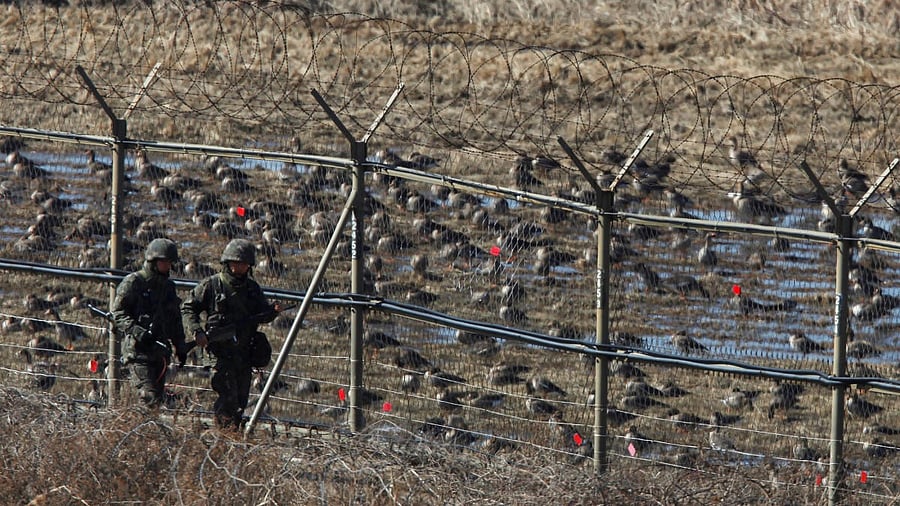
South Korean soldiers walk past birds as they patrol along a barbed-wire fence near the demilitarized zone in Paju
Photo for representational purpose.
Credit: Reuters photo
Gyodong Island: Kim Cheong San and his wife Min Ok Sun, both in their 90s, never thought their temporary tin-roof shelter built over 70 years ago in Gyodong Island in South Korea would become their permanent home after being displaced in the Korean War.
Gyodong-do (do means island in Korean) is situated along the border between North and South Korea. Like the nonagenarian couple Kim and Min, it has scores of displaced North Koreans who were engaged in the Korean War in the 1950s.
A bridge connecting Gyodong-do to Ganghwa-do, where the Demilitarised Zone (DMZ) Peace Trail is located, was built in 2014, allowing tourists to visit the area. Tourists have been visiting the area to see Daeryong village and the Daeryong Market, which has a nostalgic charm reminiscent of the 1970s.
Kim, born in 1930 in Hwanghae-do (now in North Korea), was a member of the UN8240 Eulji Tiger Brigade Association, a guerrilla unit.
This unit helped US Army soldiers in rescue operations for US Air Force pilots across the northern side, their familiar territory, after the Korean War broke out on June 25, 1950.
Min, born in the same village as her husband, came to Gyodong-do when she was only 17.
But the country was divided after the war and they never had a chance to go back. Many North Koreans, including this couple, settled temporarily in Gyodong Island when the war ended on July 27, 1953.
“The villagers here helped us refugees to settle in by building tin-roof shelters. Now, over the years, our temporary abodes have turned into forever homes,” Kim says.
“I never thought I would marry and live my whole life here. I was just longing for peace and wanted to return to my hometown to my parents and get married there, in front of them,” Min said.
The couple has three sons - all well settled in different cities of South Korea. The couple’s sons and grandchildren visit them quite often.
Like them, there are a few more Korean War veterans in the island for whom the memories of the bygone era and the pain of Korea’s division are still fresh.
Chae Ja Eok, born in 1931 in Hwanghae-do, was also a member of the UN8240 Eulji Tiger Brigade Veterans Association.
He recalls how their job was to help in rescuing the US Air Force personnel stuck in North Korea after the American jets were shot down. After becoming an official unit, they were armed with artillery and also given US Army uniforms.
He was only 19 when he came to Gyodong-do. On August 15, 1945, Korea was finally liberated from Japanese colonial rule. However, this happiness was short-lived as in the same month, the Soviet Army entered North Korea and then came the 38th Parallel, Chae says.
The 38th Parallel was initially established as a temporary border by the US and the Soviet Union after World War II to divide the areas of the Japanese surrender.
It led to the formation of North and South Korea and now the Demilitarised Zone (DMZ), a heavily fortified buffer zone separating the two countries.
“And so, in less than a month since liberation, the Korean peninsula had to go into another suffering,” Chae says.
“The pain that we, the displaced people, have gone through is unfathomable.” His guerrilla unit was helping the United Nations Command (UNC) to proceed to North Korea. They succeeded in occupying Kaesong, also spelt Gaeseong (a city in North Korea), and waited for the UNC to take over.
“When the UNC couldn’t be there on time, we had no choice but to retreat to South Korea,” he recalls the events, known as the January 4th Retreat, in 1951.
“A lot of people were displaced during this process. There were many refugees and young people who were engaged in the war but didn’t have a place to go after the end of the war. They took refuge in the islands of South Korea,” the veteran informs. Gyodong-do was one of them.
North Korea’s scenic Songak Mountain lies right across Uidu Dondae, a military-controlled area, on Ganghwa-do, where the Ganghwa Peace Observatory is located.
Apart from watching that side through binoculars, Chae says that in the past 70 years, he has learnt about life in North Korea only through the media.
However, even after living almost their entire life on the South Korean side, many of these war veterans long to visit their hometown at least once before they die. They hope that the two countries can be unified again.
“If Germany could become one, I think Koreans can also overcome their differences. We should leave our past behind and walk into the future as one Korea of one ethnicity,” Min says.